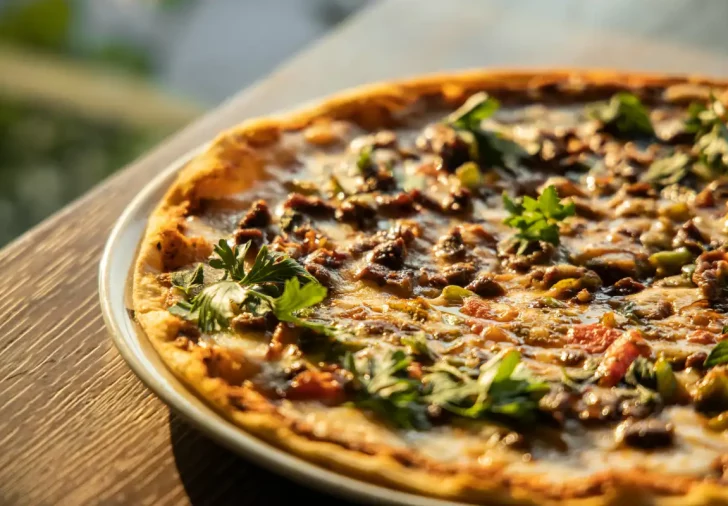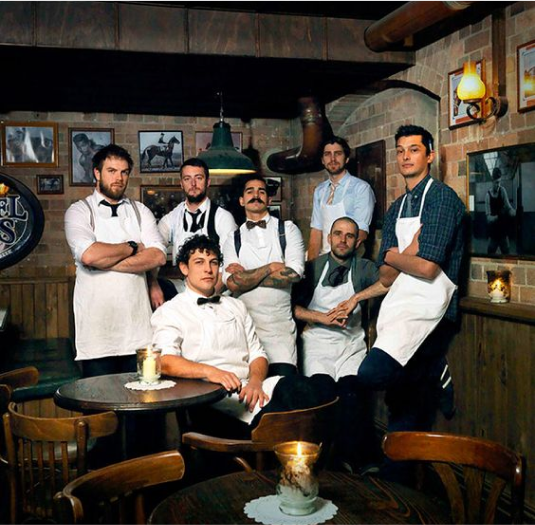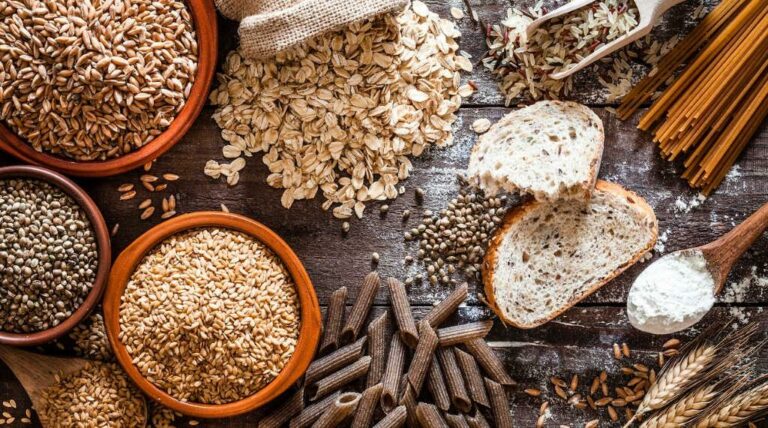Pizza, a global phenomenon with countless variations. But for Americans, a delicious debate reigns supreme: thin crust vs thick crust? Each style offers a unique flavor and texture experience.
Let’s embark on a journey to discover the secrets of thin crust vs thick crust pizzas. We’ll delve into the world of toppings, exploring classic and creative combinations that perfectly complement each crust type. We’ll also unveil the baking techniques that create the signature crispness of thin crust or the delightful chew of a thick crust. Finally, we’ll consider the overall pizza experience – from the first satisfying bite to the feeling of contentment after the last delicious slice. By the end of this exploration, you’ll be a certified pizza connoisseur, equipped to confidently choose your perfect slice!
Table of Contents
ToggleThe Difference Between Thin, Thick, and Deep Crust Pizza
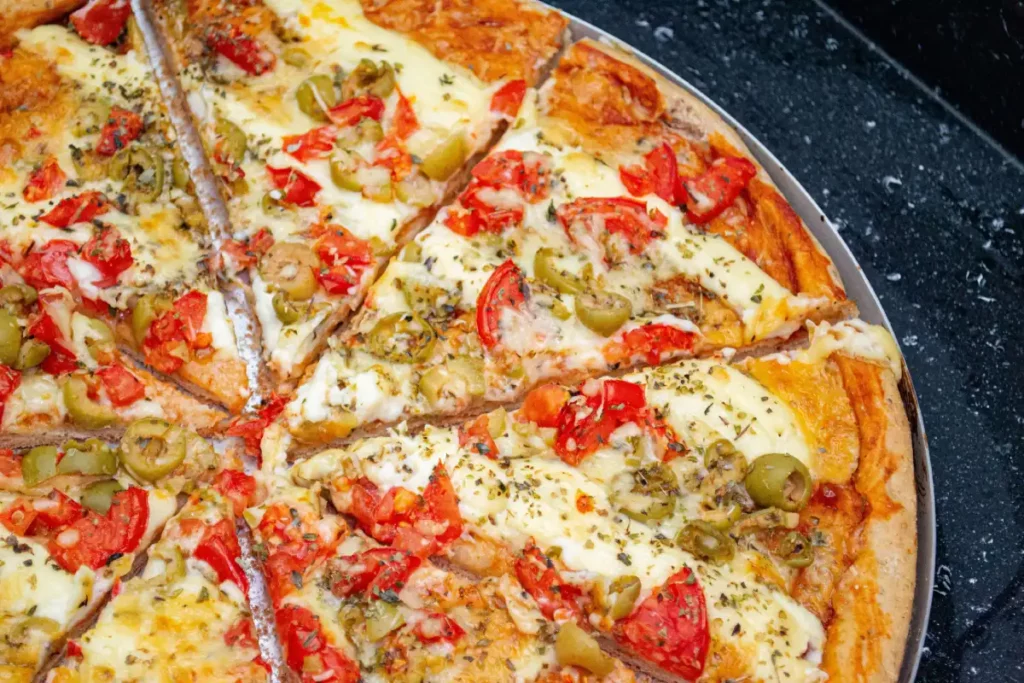
Pizza crust plays a significant role in defining a pizza’s overall experience and flavor. Choosing thin crust vs thick crust, and deep-crust pizza dough can significantly impact dining enjoyment. Let’s explore the key characteristics that differentiate these crust styles:
Thin Crust Pizza
Thin crust pizza is renowned for its delicate and crispy texture. It is rolled out thinly and baked at high temperatures, producing a light and flaky crust. The toppings take center stage, and the crust acts as a crisp foundation. Thin-crust pizza is perfect for those who prefer a lighter, less doughy eating experience. It is commonly found in Neapolitan and New York-style pizzas.
- Size: Thin crust pizzas typically have a larger diameter compared to thicker crust options, making them ideal for sharing or for those who enjoy a larger portion.
- Toppings: Toppings on thin crust pizzas are often sparse but thoughtfully chosen, enhancing the overall flavor without overwhelming the delicate crust.
- Taste: The delicate and crispy texture of thin crust pizzas allows the toppings to take center stage, resulting in a light and flavorful eating experience.
- Suitability for Different Occasions: Thin crust pizzas are well-suited for casual gatherings, quick meals, or anytime cravings for a flavorful yet lighter option.
- Difference in Calories: Thin crust pizzas tend to have fewer calories per slice compared to thicker crust varieties, making them a popular choice for those mindful of their dietary intake.
Thick Crust Pizza
Thick crust pizza offers a heartier and more substantial bite. The dough is rolled out thicker and often involves a longer rising time, resulting in a soft and chewy crust. Thick-crust pizza can hold a generous amount of toppings, making it a popular choice for those who enjoy a filling and satisfying pizza. Chicago-style deep-dish pizza and Sicilian-style pizza are well-known examples of thick crust variations.
- Size: While thick crust pizzas may have a smaller diameter compared to thin crust pizzas, they make up for it with their ability to support a heavier load of toppings.
- Toppings: The chewy texture of thick crust pizzas pairs well with a variety of toppings, from classic pepperoni and sausage to gourmet options like caramelized onions and artichoke hearts.
- Taste: Thick crust pizzas offer a heartier and more substantial bite, with a soft and chewy crust that complements the flavorful toppings.
- Suitability for Different Occasions: Thick crust pizzas are ideal for family dinners, gatherings with friends, or any occasion where a hearty meal is desired.
- Difference in Calories: Thick crust pizzas tend to have higher calorie counts per slice due to their denser dough and increased toppings, making them a more indulgent choice.
Further reading: The Best Sausage for Pizza – A Guide to Selecting the Best Option
Deep Crust Pizza
Deep crust pizza takes thickness to another level. The dough is pressed into a deep-dish pan, creating a thick and doughy base filled with layers of cheese, sauce, and toppings. Unlike the thin and thick crust styles, the toppings are nestled within the dough, resulting in a unique flavor profile and a more substantial eating experience. Deep-crust pizza, often associated with Chicago-style deep-dish pizza, is a favorite among those seeking a truly indulgent and hearty pizza option.
- Size: Deep crust pizzas are typically smaller in diameter compared to thin and thick crust options but make up for it with their depth and richness.
- Toppings: The layers of cheese, sauce, and toppings create a decadent flavor profile that’s both savory and satisfying in deep crust pizzas.
- Taste: Deep crust pizzas offer a unique flavor profile with toppings nestled within the dough, resulting in a rich and indulgent eating experience.
- Suitability for Different Occasions: Deep crust pizzas are perfect for special occasions, celebrations, or anytime cravings for a truly indulgent meal strike.
- Difference in Calories: Due to their thick and doughy nature, deep crust pizzas tend to have the highest calorie content per slice among the three crust styles, making them a more occasional treat for those watching their calorie intake.
The Most Popular Pizza Crust Styles Around the World
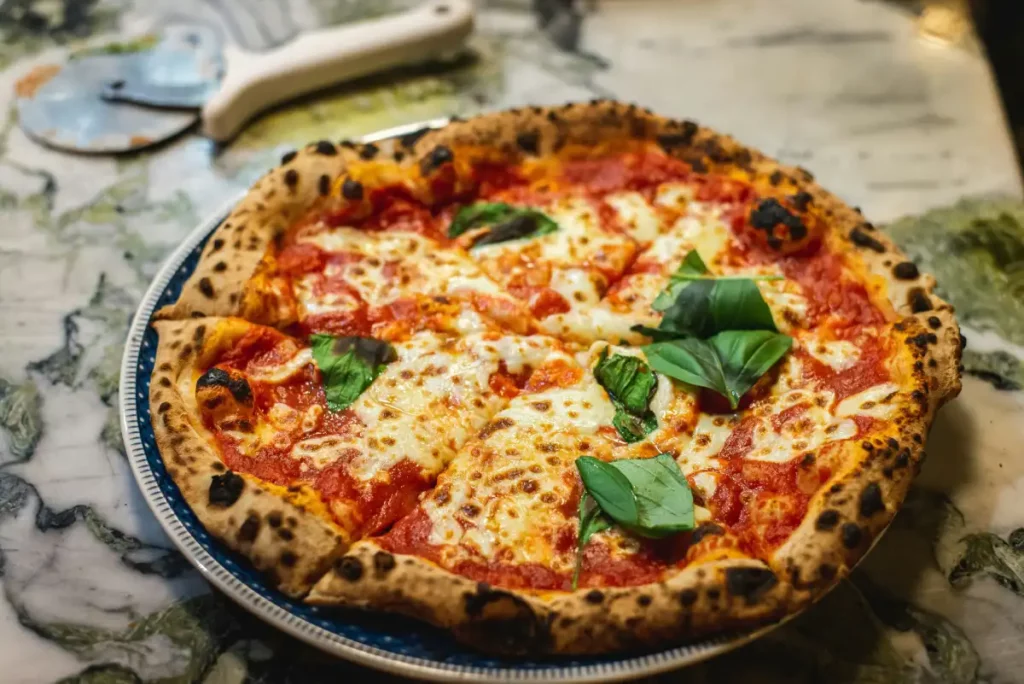
Pizza, a global favorite, has evolved into countless regional variations, each with its distinctive crust style pizza toppings. Let’s explore some of the most popular pizza crust styles enjoyed around the world:
1. New York-Style Pizza (United States)
- Iconic Status: Symbol of American pizza culture, particularly in New York City.
- Characteristics: It has a crisp exterior with a chewy interior. It is often topped with a generous amount of tomato sauce and mozzarella cheese. New York-style pizza is beloved for its size, flavor, and portability.
- Eating Experience: Highlight the quintessential New York pizza experience of grabbing a slice on the go, the bustling pizzerias, and the communal atmosphere of sharing a pie with friends.
3. Chicago-Style Deep-Dish Pizza (United States)
- Origin: Pizza style that originated in Chicago, Illinois.
- Characteristics: The crust is deep, buttery, and flaky, resembling a pie crust more than a traditional one. It is layered with cheese, toppings, and chunky tomato sauce.
3. California-style Pizza
- Origin: California-style pizza originated in the Golden State
- Characteristic: Thin, crispy crust topped with non-traditional ingredients like avocado, artichokes, and sun-dried tomatoes.
4. Sicilian-Style Pizza (Italy)
- Origin: Sicilian origins of this pizza style
- Characteristics: Sicilian-style pizza, also known as “sfincione,” features a thick, rectangular crust that is light and fluffy inside and crispy on the bottom. It is often topped with tomato sauce, cheese, and various toppings. Sicilian-style pizza is known for its robust flavors and substantial size.
5. Lahmacun (Turkey)
- Origin: Turkey
- Characteristics: Lahmacun is a thin, crispy flatbread topped with a flavorful mixture of minced meat (usually lamb or beef), vegetables, and herbs. It is rolled up and typically enjoyed as street food or a snack. Lahmacun offers a unique and delicious alternative to traditional pizza crusts.
6. Greek Pizza
- Origin: Mediterranean
- Characteristic: Thick, chewy crust topped with a tangy tomato sauce, feta cheese, olives, and fresh herbs with a combination of savory and salty ingredients that evoke the flavors of the Mediterranean.
7. Neapolitan Pizza (Italy)
- Origin: Naples, Italy, and designated a UNESCO cultural heritage.
- Characteristics: Neapolitan pizza boasts a thin, soft, and slightly chewy crust, traditionally cooked in wood-fired ovens at high temperatures. Toppings are elegantly simple with San Marzano tomatoes, fresh mozzarella, and fragrant basil, creating a rustic yet refined pizza experience that highlights the quality of its ingredients.
Further reading: How Many Slices in a 16-Inch Pizza?
How to Make Pizza Crust Thin and Soft?
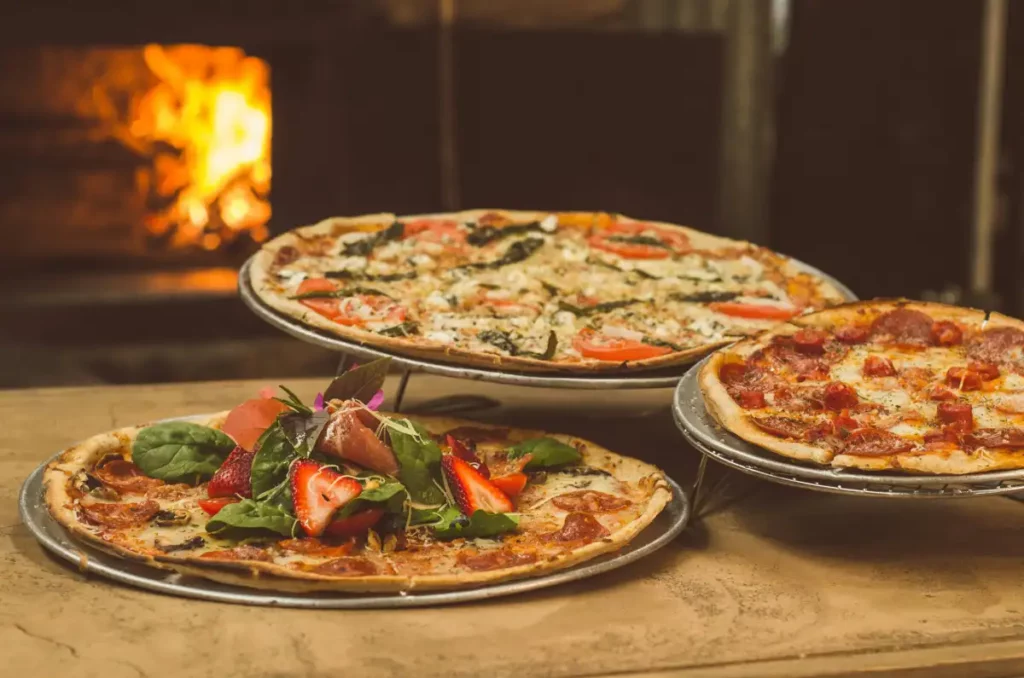
Making a thin and soft pizza crust requires attention to detail in the ingredients and the preparation method. Here’s a step-by-step guide to achieving the perfect thin and soft pizza crust:
Ingredients:
- 2 1/4 cups (270g) all-purpose flour
- One teaspoon sugar
- One teaspoon salt
- One tablespoon of olive oil
- 1 cup warm water (110°F/45°C)
- One packet (2 1/4 teaspoons) of active dry yeast
Instructions:
- Activate the yeast: Combine warm water and sugar in a small bowl. Sprinkle the yeast over the water and let it sit for about 5-10 minutes until frothy and bubbly. This indicates that the yeast is active.
- Prepare the dough: In a large mixing bowl, combine the flour and salt. Make a well in the center and pour the activated yeast mixture and olive oil. Stir until a shaggy dough forms.
- Knead the dough: Transfer the dough to a floured surface and knead for 5-7 minutes until smooth and elastic. If the dough is too sticky, add a little more flour. If it’s too dry, add a splash of water.
- First rise: Place the dough in a lightly greased bowl, cover it with a clean kitchen towel or plastic wrap, and let it rise in a warm, draft-free place for about 1-2 hours until doubled in size.
- Preheat the oven: Preheat your oven to the highest temperature possible, usually around 475-500°F (245-260°C). If you have a pizza stone, place it in the oven to preheat.
- Shape the dough: Once it has doubled, punch it down and divide it into two equal portions. On a lightly floured surface, roll out each portion of dough into a thin circle or rectangle, depending on your preference.
- Par-bake the crust (optional): For an extra crispy crust, you can par-bake the dough for 5-7 minutes before adding toppings. This helps prevent the crust from becoming soggy.
- Add toppings: Place your desired toppings on the rolled-out dough, leaving a small border around the edges for the crust.
- Bake the pizza: Carefully transfer the topped pizza onto a preheated pizza stone or baking sheet lined with parchment paper. Bake in the oven for 10-15 minutes or until the crust is golden brown and the toppings are bubbly and melted.
- Serve and enjoy: Remove the pizza from the oven and let it cool for a few minutes before slicing and serving. Enjoy your homemade thin and soft pizza crust with your favorite toppings!
Following these steps, you can create a delicious thin and soft pizza crust that is perfect for enjoying with your favorite toppings. Experiment with different toppings and flavor combinations to customize your homemade pizza slices to your liking.
Conclusion
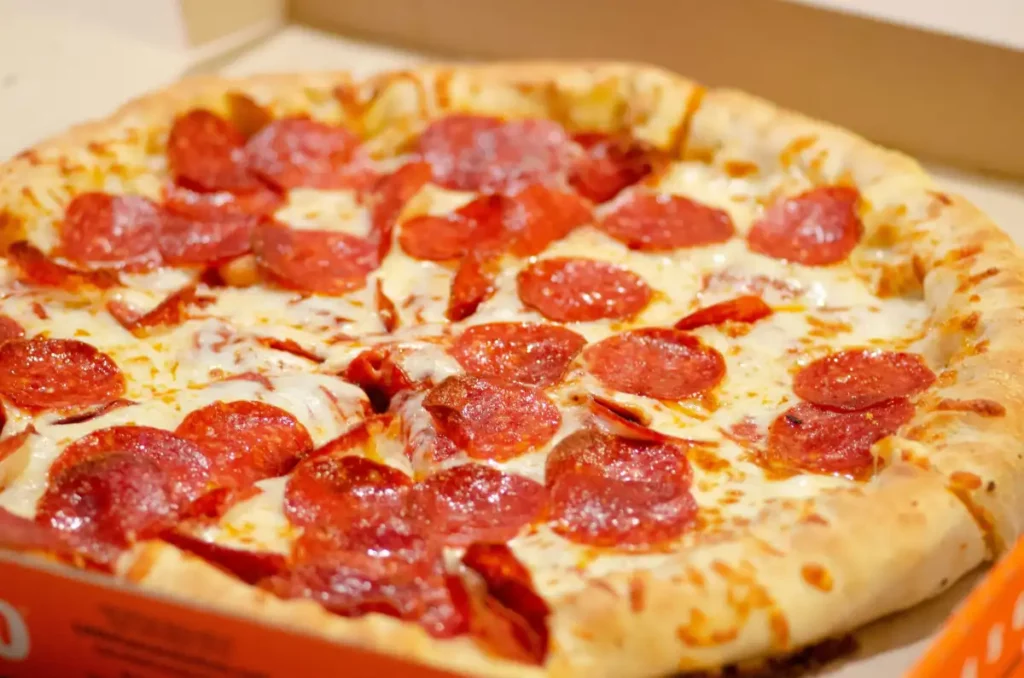
In conclusion, the debate between thin crust vs thick crust pizzas continues to ignite passionate discussions among both pizza makers and enthusiasts. The choice between these two styles ultimately comes down to personal preference and the desired eating experience. Thin crust pizzas offer a delicate and crispy bite, allowing the flavors of the toppings to shine through, while thick crust pizzas provide a heartier and more substantial bite, perfect for those seeking a satisfying and filling meal.
Whether you find yourself in the thin crust camp, savoring the lightness and crispness, or you prefer sinking your teeth into a thick crust pizza, relishing the doughy and chewy texture, the world of pizza offers something for everyone. And let’s not forget the vast array of specialty crusts that cater to unique tastes and dietary needs.
If you’re eager to explore the world of pizza crusts and indulge in a delicious dining experience, we invite you to come and visit HomeSlyce. Our expertly crafted thin and thick crust pizzas are made with love and attention to detail, ensuring a memorable and mouthwatering experience. Come and try our pizzas, where the original pizza crust is a testament to our commitment to quality and flavor.
So, whether you’re a thin crust aficionado or a thick crust devotee, let your taste buds guide you on a culinary adventure as you embrace the delightful differences between these two beloved pizza crust styles. Visit Homeslyce and discover the magic that lies within our pizza crusts. Your pizza journey awaits!

